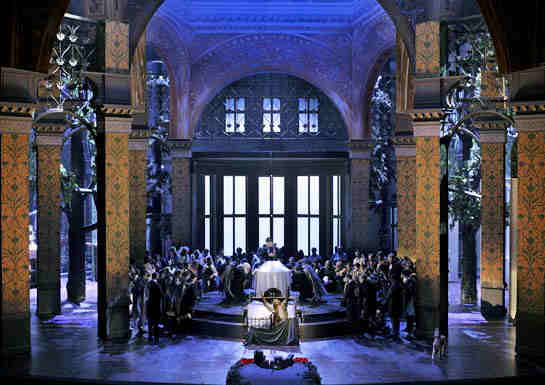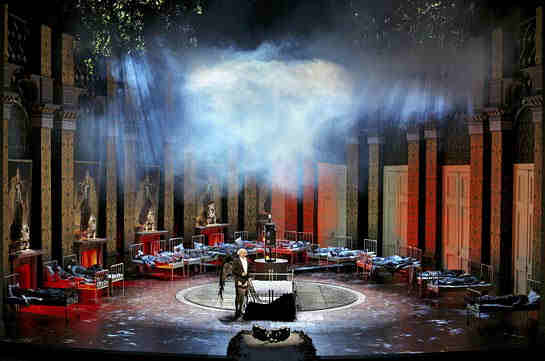Other Links
Editorial Board
- Editor - Bill Kenny
- London Editor-Melanie Eskenazi
- Founder - Len Mullenger
Google Site Search
SEEN
AND HEARD INTERNATIONAL OPERA REVIEW
Bayreuth
Festival [3] Wagner, Parsifal:
Soloists,
Chorus and Orchestra of the Bayreuth Festival. Conductor: Daniele
Gatti. Bayreuth Festspielhaus, 28.8.2008 (JPr)
What Herheim has given us, while undoubtedly a feast for the eyes,
also fills the stage almost as Schlingensief did and certainly
leads to confusion in
Acts I and II; initially as to when and where are
we and which character is which. Someone told me that
there were more wings to be seen on
stage in the first two acts than in Berlin’s Gay Pride event or a
Kylie Minogue concert. In Act II there were many
other influences at work, including the musical Cabaret for
Klingsor’s Marlene Dietrich-inspired MC in
tights, and also
the film/musical The Producers
complete with its fictional play ‘Springtime for Hitler’ (‘
In Act III we are in the garden of the ruined Villa Wahnfried circa 1945. Everything is more conventional and as a result
more coherent but I guessed very early on that the spear would
reappear from the broken Wahnfried fountain from which water would flow.
There is more than a hint of Chéreau in the stage pictures at this
point. During the transformation music we get the aforementioned

Parsifal - End of Act I
In the centre of Bayreuth every morning of the Festival, the Wagner
expert and outstanding pianist, Stefan Mickisch, gives an
introductory talk to that evening’s opera. His lecture on
Parsifal
was one of the best I have attended full of musical analysis and
piano virtuosity. He had begun by recounting the well-known tale
about Knappertsbusch and Wieland Wagner’s famous 1951
production. The conductor when asked how he could conduct a
‘travesty’ that ignored Wagner’s wishes replied that right up until
the dress rehearsal he believed he was still to see the proper stage
sets. What upset Knappertsbusch most particularly was the absence of
the dove that Wagner states appears over Parsifal's head at the end
of the opera. ‘The ray of light falls from above, and the Grail
glows brightest. From the dome a white dove descends and hovers over
Parsifal’s head’ is a version of the original instructions in the
score, and Knappertsbusch claimed that seeing the ‘dove’ inspired
him to give better performances. To placate his conductor Wieland
reinstated the dove. At the proper moment the bird descended on a
string into Knappertsbusch’s view: he did not realise that string
was only long enough for him to see it however or that nobody in the
audience could.
There was no dove for the
same
transcendent final moments of this sublime work in Christoph
Schlingensief’s 2004 Bayreuth Parsifal production either
and the production suffered premature eviction from the Green
Hill after only four years. There we saw two dead rabbits on a
screen above the stage, their rotting bodies intertwined and
followed on with the speeded-up
decomposition of one of them showing maggots at their work. This was
undoubtedly very unsettling and though Schlingensief also overfilled
the stage with visual effects left, right and centre so that the
eyes never knew where to settle, this production held a certain
fascination for me both times that I saw it. So did his setting of
the production in Namibia (apparently) with a great deal of tribal
imagery included although this led to a certain amount of not so
acceptable ‘black face’ make-up for the singers. When Endrik
Wottrich, who sang Parsifal, voiced his concerns about the staging
calling it an ‘abomination’, Schlingensief
accused him of being a racist who objected to the number of black
actors in it. So on the one hand we had the provocateur and on the
other the sentimentalist who could so easily be deemed a fascist.
This contrast
between provocation and sentimentalism/traditionalism is
also explored by Katharina
Wagner's
much
savaged Die Meistersinger production.
Replacing Schlingensief this time, is the young Norwegian
stage director, Stefan Herheim, a former cellist and student of Götz
Friedrich. He was aided and abetted by Heike Scheele’s sets, Gesine
Völlm’s costumes and by Alexander Meier-Dörzenbach’s dramaturgy.
Having seen the results of the collaboration
I concluded that
since this complex and involved staging did not evolve
overnight someone must have decided to
ditch the Schlingensief production very soon after its première – a
response to the row with Wottrich perhaps?

Act II
The kitsch and ambiguities may be deliberate of course, since Herheim raises more questions than he resolves. It is his good
fortune that after two uncomfortable acts giving us a mish-mash of
three possible alternative narratives he has a much clearer approach to Act III.
The earlier narratives are firstly,
Parsifal's birth, upbringing a child and developing as a young man,
secondly some reflection on German history through the late
nineteenth to mid-twentieth century and thirdly, a commentary on the
Bayreuth Festival during that time when the audience
is shown ‘Hier
gilt’s der Kunst’ (Our aim is art) the slogan from Bayreuth’s
reopening after WWII.
The exterior, garden and small fountain of Richard Wagner’s Villa
Wahnfried are regular features of the sets in some way for all three
acts as is Wagner’s grave shown in the area of the prompt box. Act I
begins as Herzeleide dies giving birth to Parsifal during the
Prelude. Do the black wings worn by Gurnemanz and Kundry reflect those
of the
eagle on the national emblem? The setting appears to be a royal court
from the nineteenth-century but Ludwig II’s mother did not die in
childbirth, nor did the mothers of Kaiser Wilhelm II, Richard
Wagner, Siegfried Wagner, Nietzsche or Hitler - so who is the
sailor-suited Parsifal supposed to be exactly? Perhaps I am seeking
too much coherence of course and in such a
philosophical-spiritual-redemptive and musical interpretation, it is
an unreasonable expectation.
Yet maybe
not in circumstances where there is such a specific Wilhelminian
time frame. Amfortas is a Jesus figure and the Grail is the
traditional goblet or even at the end of Act I the newly born and
circumcised (yes this is shown too) Parsifal himself who/which is carried
around on display. All of
this only barely hints at the rest of what happens on stage
In Act II, we are the early 1930s of Dietrich’s The Blue Angel
and the German film industry. Various film projections show the
build up to WWI, death and destruction and then the onset of WWII.
The villa is now an army hospital with the flower maidens
as nurses or cabaret girls who eventually mount the invalids and 'try to
cheer them up.' Parsifal, still in sailor suit, is seen jumping down
from the Wahnfried balcony. As suggested earlier, Herheim now cranks
the kitsch up to a ridiculous level. I have not mentioned the silly
rag-doll-like defeated ‘troops’ thrown about on stage, nor the
stage smoke that starts too early or the totally botched transfer of
the spear from a member of the Hitler youth to Parsifal. The waving of
this ‘spear’ fells the Nazi soldiers - accompanied by much suppressed laughter from
some of the audience.
.jpg)
Act III
The principal casting was drawn from a variety of nations with only
two Germans in it - Detlef Roth’s suitably anguished Amfortas, showing
him to be a consummate singer-actor and Thomas Jetsako’s Klingsor
whose voice lacked true focussed malevolence but whose long legs
suited the Dietrich character he was given to play.
Diógenes Randes has the necessary sepulchral tones for Titurel but Kwangchul Youn’s wonderfully well schooled bass
and
excellent diction lacked the gravitas necessary for Gurnemanz. This
role is usually given to a more senior bass who may not retain the
flexibility of a more youthful voice but can bring greater insight
into delivering Wagner’s text and so command more attention for his
long narration. Nevertheless Youn seemed totally at ease with what
Herheim asked him to do.
Herheim
also gives Kundry a lot to do from the point of view
of pure acting. She appears first as Herzeleide (Parsifal’s mother), then as
a servant girl expelled right
after Parsifal’s birth and then - significantly
- as Herzeleide once more
when she attempts
to seduce her own son. She also assumed other guises during the
evening and may even be considered to be yet another version of the
Grail in Act I if we accept the ‘grail-as-womb’ idea.
Mihoko
Fujimara was adequate to all of the
tasks she was given but her voice
lacks any real sensual beauty and her top notes were shrill and
effortful.
I think I am correct in saying that this may be the first time a Brit has sung
one of the main headline heldentenor roles at Bayreuth though we
have had significant British success in other
fachs over recent
years. Christopher Ventris had to
progress from being an
overgrown petulant boy, to developing some
maturity (though still looking a bit uncomfortable in the sailor suit)
before gaining the necessary redemptive messianic charisma at the end.
Vocally he was also at his best during the final moments,
when his ‘Nur eine Waffe taugt’ was ecstatic with a glorious ring to it
which
concluded a notable Bayreuth debut.
The chorus as always were in superb form whilst in the pit, Daniele
Gatti’s approach to his reading right from the Act I Prelude was
broad, with an unerring sense of smooth arch and line and immense
pauses just a milli-second short of the music stopping entirely. The
music remained as radiant and emotional as one would expect at
Bayreuth with its always reliable orchestra
and I must also mention
that the bells that were some of the best I have ever heard.
Musing on the role of the conductor
however, I did wonder how free Gatti was
to
decide on pace of his performance in this
production. Surely he must have been restricted by
the amount of video material shown and reduced to
mere accompanist to the stage director’s wishes
at some points. But does this matter
actually matter much if true, and as
an idle thought, what
might Knappertsbusch have made of these developments? He would have liked the dove of course.
By including the more ‘traditional’ Act III Stefan Herheim
ensures that this Parsifal will be acclaimed
however. There was no
problem with cheering everyone involved on the final night of this 97th
Bayreuth Festival, and after the
performers' curtain calls,
Wolfgang Wagner
came on stage to wave goodbye and
received a deserved standing ovation.
Within a few days, the directorship
had moved smoothly to the triumvirate
of Katharina Wagner, Eva Wagner-Pasquier and Christian Thielemann
and a new day for Bayreuth had dawned.
Jim
Pritchard
Pictures Bayreuther Festspiele GmbH / Enrico Navarath
Back
to Top
Cumulative Index Page
